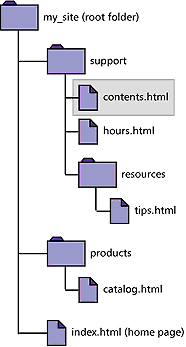Linking and Navigation > About document locations and paths > Document-relative paths
Linking and Navigation > About document locations and paths > Document-relative paths |
Document-relative paths are the most appropriate paths to use for local links in most Web sites. They're particularly useful when the current document and the linked document are in the same folder and are likely to remain together. You can also use a document-relative path to link to a document in another folder, by specifying the path through the folder hierarchy from the current document to the linked document. The basic concept behind document-relative paths is to omit the part of the absolute URL that is the same for both the current document and the linked document, providing only the portion of the path that differs.
| To link to another file in the same folder as the current document, simply enter the file name. | |
| To link to a file in a subfolder of the current document's folder, provide the name of the subfolder, then a forward slash (/), and then the file name. | |
| To link to a file in the parent folder of the current document's folder, precede the file name with ../ (where ".." means "up one level in the folder hierarchy"). |
For example, suppose you have a site with this structure:

To link from contents.html to other files:
| To link from contents.html to hours.html (both files are in the same folder), the file name is the relative path: hours.html. | |
| To link to tips.html (in the subfolder named resources), use the relative path resources/tips.html. | |
| Each forward slash (/) represents moving down one level in the folder hierarchy. | |
| To link to index.html (in the parent folder, one level above contents.html), use the relative path ../index.html. | |
| Each ../ represents moving up one level the folder hierarchy. | |
| To link to catalog.html (in a different subfolder of the parent folder), use the relative path ../products/catalog.html. | |
| The ../ moves up to the parent folder; the products/ moves down into the products subfolder. |
Note: Always save a new file before creating a document-relative path; a document-relative path is not valid without a definite starting point. If you create a document-relative path before saving the file, Dreamweaver temporarily uses an absolute path beginning with file:// until the file is saved; when you save the file, Dreamweaver converts the file:// path into a relative path.
When you move a group of files as a group—for example, when you move an entire folder, so that all the files inside that folder retain the same relative paths to each other—you don't need to update document-relative links between those files. When you move an individual file that contains document-relative links, however, or an individual file that's linked to by a document-relative link, you do need to update those links. (If you move or rename files using the Site window, Dreamweaver updates all relevant links automatically.)